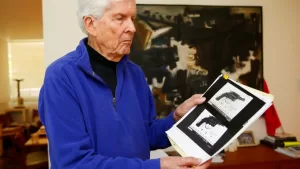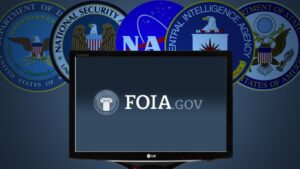
In this Thursday, May 31, 2018, photo, Sen. Robert Kennedy aide Paul Schrade holds an evidence photo of gunman Sirhan Sirhan’s revolver with the eight expended shell casings found in the chamber, and the Weisel, Goldstein, and Kennedy bullets, at his home in Los Angeles. When a gunman open fire toward Sen. Robert Kennedy, the first bullet missed the senator and struck Kennedy aide Paul Schrade in the head. Schrade woke up the next day and found out the Democratic presidential candidate was dead. Today, Schrade believes the Los Angeles Police botched the case and failed to investigate possible leads about a second gunman. (AP Photo/Damian Dovarganes)
Sirhan Sirhan, the man convicted of killing Robert F. Kennedy in 1968, was granted parole Friday. Sirhan was convicted of shooting and killing the presidential candidate and wounding five others at the Ambassador Hotel in Los Angeles.
Kennedy had just delivered a speech after winning the California primary. He was gunned down in a hotel hallway moments later.
Among those shot that night by Sirhan was Paul Schrade, a current board member of the Dolores Huerta Foundation. At that time Schrade was with the United Auto Workers and part of the Kennedy campaign.
“They thought I was dead,” said Schrade in a phone interview with 17 News. “A friend of mine from a different union came and put a voter straw hat over my head because he thought I was dead, but then he checked my pulse and found I wasn’t.”
Schrade believes Sirhan was not the one who shot and killed Kennedy and that a second gunman was involved. For the past 52 years, Schrade has been working to bring to light evidence he said proves Sirhan was not the one responsible for killing Kennedy.
“Who was this guy they were covering up? Who was so important for the district attorneys to keep covering up for 52 years that shot RFK?” said Schrade.
Despite being shot by Sirhan, Schrade adds he holds no animosity toward him.
“I don’t excuse him for what he did, but I don’t excuse the LAPD and the district attorneys for 52 years of saying he’s guilty when he is not,” said Schrade.
READ MORE at KGET
The Associated Press contributed to this report.

















